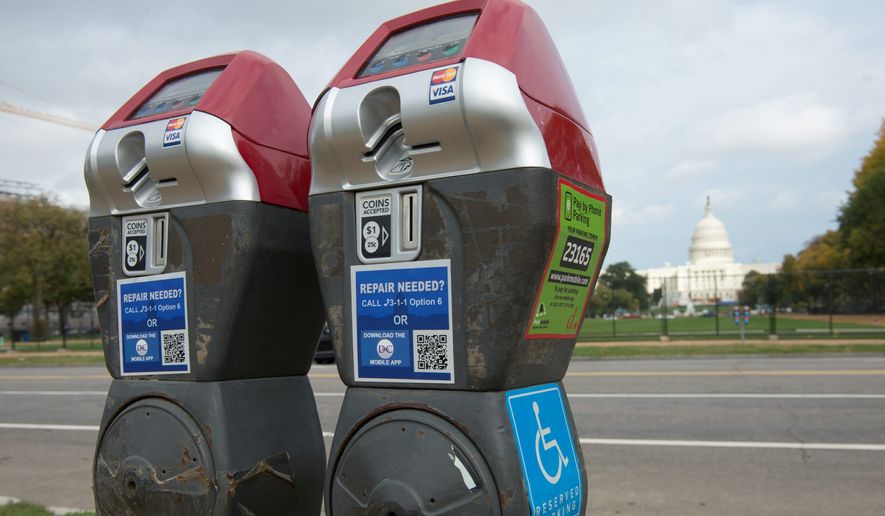Parking meters that were part of a program to reserve spaces for disabled drivers were installed in such a haphazard manner in the waning days of Mayor Vincent C. Gray’s administration that incoming transportation officials plan to remove a slew of them before advancing the program.
The District’s Department of Transportation has installed about 1,200 “red-top” parking meters across the city since 2012, with the meters “popping up like little weeds” as Mr. Gray’s term wound down last year, said D.C. Council member Mary M. Cheh.
But the rush to install the meters in a program that is not fully functional oversaturated some city wards with as many as six handicapped meters on one block in some areas, DDOT officials said.
“One of the reasons there are so many meters clustered together in a confusing and illogical way is that there was just an overall goal to install 1,200 and to hit a number,” said DDOT’s new acting director, Leif Dormsjo. “So that lead to a whole bunch of perverse outcomes.”
Ms. Cheh, Ward 3 Democrat, and other council members peppered Mr. Dormsjo with questions about how he would fix the troubled program during an oversight hearing Friday. Some worried the overzealous meter installation will make it too difficult for others to find street parking.
“The best way to handle this is to start to clean up the most egregious examples of where we’ve got too many meters concentrated the same area,” said Mr. Dormsjo, noting a disproportionate amount in Wards 2 and 6.
SEE ALSO: Pro-life, Catholic groups barking over AIDS program
Mr. Dormsjo said he would like to see the number of meters reduced by at least 150, with the possibility of removing scores of others after a review. Ideally, Mr. Dormsjo said he’d like the percentage of parking meters dedicated to handicapped drivers to equate with the percentage of disabled residents, about 7 percent. But the city’s robust paratransit network, which provides transportation services for disabled residents, may further reduce the number of red-top spots needed.
Disabled drivers with a government-issued handicapped parking placard currently can park in any of the 18,500 metered spots in the District for free for any length of time. DDOT estimated the city lost out on $1.5 million to $2.1 million in revenue due to free handicapped parking in fiscal 2011.
The red-top program would reserve the meters for disabled drivers, who would be required to pay the standard rate for parking but could remain in the spots for four hours at a time. Anyone without a handicapped placard who parked at the meters could be fined $250. The program was intended to provide the city a way to collect fees from disabled drivers, a change city officials hoped would cut down on the use of counterfeit placards.
With the fate of the red-top program in limbo, all drivers are allowed to park at the meters.
DDOT’s rollout of the plan in early 2012 hit snags when lawmakers balked at the proposal and questioned why there had not been more public discussion. Mayor Muriel Bowser, then the D.C. Council member representing Ward 4, led the charge to block the implementation of the red-top meter plan for a 90-day period.
In late 2012, the D.C. Council voted down legislation that would have implemented the program — after about 400 red-top meters were installed — and the plan stalled. But in August 2014, DDOT quietly proposed relaunching the program and began installing the rest of the meters.
SEE ALSO: In D.C., old campaign signs linger, drawing few, if any, fines
The stop-and-go rollout of the program has left disabled and able-bodied drivers unclear about where they can and cannot park, lawmakers said.
“We have on a best-case scenario, utter confusion about how the program is working,” said D.C. Council member Charles Allen, who represents Ward 6, which has a heavy concentration of the meters.
Before moving forward, Mr. Dormsjo said he would like to bring affected parties like commercial business owners, advocates from the disabled community and residents together to discuss the red-top meters in the hopes of settling on a more agreeable plan. He told council members that similar programs in other jurisdictions, including Baltimore, have had success curbing fraudulent use of handicapped parking placards but that he doesn’t intend to move forward on the program without the council’s blessing.
• Andrea Noble can be reached at anoble@washingtontimes.com.




Please read our comment policy before commenting.